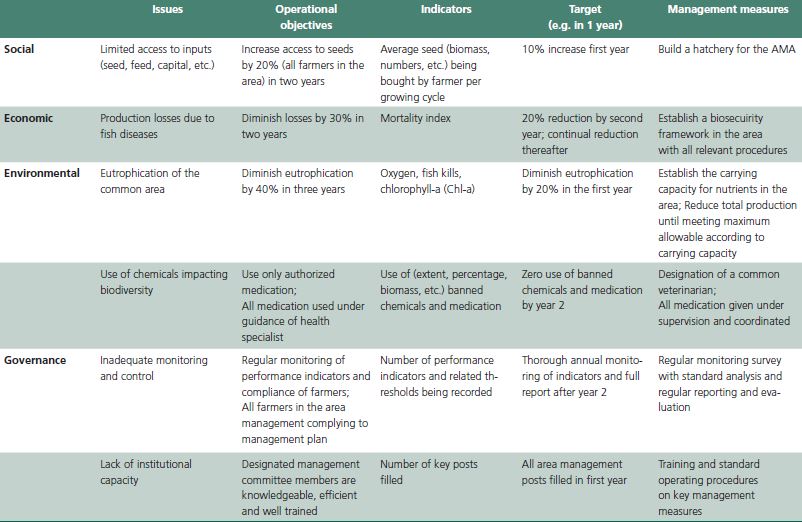6.7. Essential steps in the implementation, monitoring and evaluation of a management plan for an AMA
The implementation of the management plan should be time bound. Two aspects are important relative to a time frame. The first is to decide on a base year for the management system. This will represent a year (or period) against which progress can be measured.
The second time aspect relates to target years or periods by which various aspects of the work plan can be achieved, or by which any quantitative programme output should be attained. Overall, it is likely that the management system should be envisaged as spanning
TABLE 12. Examples of indicators for aquaculture management areas

a 5- to 10-year time frame, but during this period the system will need periodic reviews over shorter time scales.
The management plan must address all the relevant issues, have very clear and achievable operational objectives for each issue, and a clear timeline for completion with targets and indicators (Table 12).
The management plan must have responsible people/institutions/entities and requires adequate funding for each management approach and also must have resources to implement the measures as appropriate. Since it will generally be the central government that will be implementing the work, financing will mainly come from general tax revenues, though other sources of funding include stakeholder contributions, funding from external donors, international and multinational organizations, grant funding, foundations and the private sector. Since many of the activities that stand to gain from a management system will be in the private sector, it would not be unreasonable to expect that a range of business associations might be willing to help with financing. For example, an alternative source of funding tried in China is that all users of the sea must pay a “marine user fee” if they intend to carry out production and other economic activities.
It is almost certain that the eventual financial support will be delivered from more than one source. Clearly, funding will need careful planning ahead of the systems implementation.
Performance indicators must be set to inform whether set targets are being achieved, while efficiency indicators would show if there has been any improvement. The indicators that are selected should cover sustainability dimensions–social, economic, environmental, and overarching governance–at the aquaculture area scale. For each objective, an indicator and its associated performance measures should be selected so that the performance of each objective can be measured and verified (Table 12 and Table 13). The choice of indicators to be measured should reflect the cumulative impacts within the management area.
A monitoring programme to keep track of implementation must be put in place. In the context of an AMA, monitoring keeps track of the progress of the management plan based on indicators. Just as important, it provides an indication of compliance by AMA members with the agreed plan. Monitoring involves: (i) continuous or ongoing collection and analysis of information about implementation to review progress; and (ii) compares actual progress with what had been planned so that adjustments can be made in implementation.
Corrective measures can be implemented, an important part of which are sanctions to nonconforming members. The result of monitoring gives a factual, objective basis for a sanction. Should non-compliers persist, a defined conflict-resolution mechanism has to be agreed on and firmly applied.
TABLE 13. Examples of management plan objectives and indicators to address the prioritized issues

That said, the use of incentives for compliance can be a more effective measure than a sanction.
The regular monitoring of management performance may show that the area management plan needs to be adjusted. If current management measures do not seem to be working or are deemed inappropriate, alternative measures need to be introduced. In some cases, some measures may be rendered unnecessary if the issue has been solved. In other cases, changes in issues or priorities could end the relevance of a measure. The management plan should in any case be reviewed periodically, e.g. once a year or every two years according to needs. This underlines the importance of monitoring and evaluation.